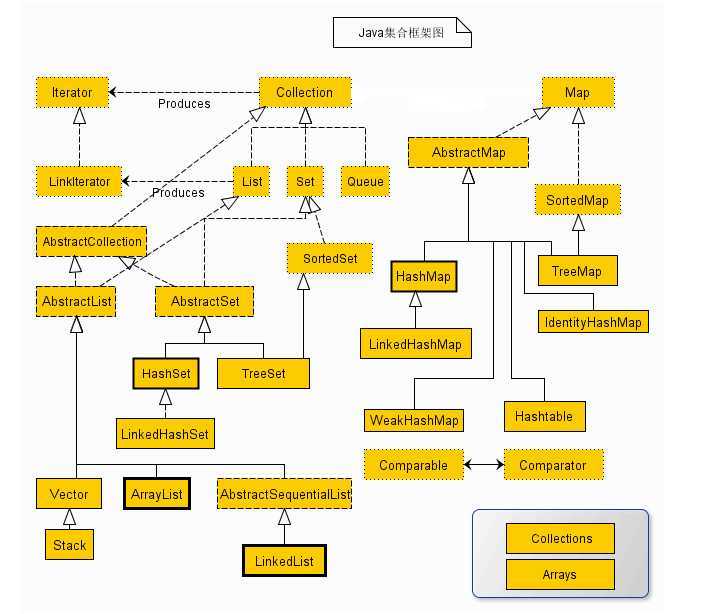标签:style class blog code java http
Set接口的实现,可以方便地将指定的类型以集合类型保存在一个变量中。Set是一个不包含重复元素的Collection,更确切地讲,Set 不包含满足 e1.equals(e2) 的元素对,并且最多包含一个 null 元素。Set接口的底层存储实现都是依赖Map的实现,也可以说Set中元素的管理就是对Map中key的管理。下面简单描述一下各种Set接口的实现类,主要包括HashSet,LinkedHashSet,TreeSet

1、HashSet
HashSet底层是有HashMap实现的,存储的是[key-Object常量]这样的键值对,同样包括initialCapacity和loadFactor两个参数,这两个参数的意义和HashMap一样,都是比较重要的。另外,HashSet集合里边的元素是无序的。
public class HashSet<E> extends AbstractSet<E> implements Set<E>, Cloneable, java.io.Serializable { static final long serialVersionUID = -5024744406713321676L; private transient HashMap<E,Object> map; // Dummy value to associate with an Object in the backing Map private static final Object PRESENT = new Object(); /** * Constructs a new, empty set; the backing <tt>HashMap</tt> instance has * default initial capacity (16) and load factor (0.75). */ public HashSet() { map = new HashMap<E,Object>(); } /** * Constructs a new set containing the elements in the specified * collection. The <tt>HashMap</tt> is created with default load factor * (0.75) and an initial capacity sufficient to contain the elements in * the specified collection. * * @param c the collection whose elements are to be placed into this set * @throws NullPointerException if the specified collection is null */ public HashSet(Collection<? extends E> c) { map = new HashMap<E,Object>(Math.max((int) (c.size()/.75f) + 1, 16)); addAll(c); } /** * Constructs a new, empty set; the backing <tt>HashMap</tt> instance has * the specified initial capacity and the specified load factor. * * @param initialCapacity the initial capacity of the hash map * @param loadFactor the load factor of the hash map * @throws IllegalArgumentException if the initial capacity is less * than zero, or if the load factor is nonpositive */ public HashSet(int initialCapacity, float loadFactor) { map = new HashMap<E,Object>(initialCapacity, loadFactor); }
2、LinkedHashSet
LinkedHashSet继承了HashSet,但它底层存储使用的是LinkedHashMap,所以其中的元素是按照插入有序的。看LinkedHashSet类只是定义了四个构造方法,也没看到和链表相关的内容,为什么说LinkedHashSet内部使用链表维护元素的插入顺序(插入的顺序)呢?点进去看下这个三个参数的构造方法HashSet(int initialCapacity, float loadFactor, boolean dummy),就会发现使用的实现类是LinkedHashMap了:
public class LinkedHashSet<E> extends HashSet<E> implements Set<E>, Cloneable, java.io.Serializable { private static final long serialVersionUID = -2851667679971038690L; /** * Constructs a new, empty linked hash set with the specified initial * capacity and load factor. * * @param initialCapacity the initial capacity of the linked hash set * @param loadFactor the load factor of the linked hash set * @throws IllegalArgumentException if the initial capacity is less * than zero, or if the load factor is nonpositive */ public LinkedHashSet(int initialCapacity, float loadFactor) { super(initialCapacity, loadFactor, true); } /** * Constructs a new, empty linked hash set with the specified initial * capacity and the default load factor (0.75). * * @param initialCapacity the initial capacity of the LinkedHashSet * @throws IllegalArgumentException if the initial capacity is less * than zero */ public LinkedHashSet(int initialCapacity) { super(initialCapacity, .75f, true); } /** * Constructs a new, empty linked hash set with the default initial * capacity (16) and load factor (0.75). */ public LinkedHashSet() { super(16, .75f, true); }
/** * Constructs a new, empty linked hash set. (This package private * constructor is only used by LinkedHashSet.) The backing * HashMap instance is a LinkedHashMap with the specified initial * capacity and the specified load factor. * * @param initialCapacity the initial capacity of the hash map * @param loadFactor the load factor of the hash map * @param dummy ignored (distinguishes this * constructor from other int, float constructor.) * @throws IllegalArgumentException if the initial capacity is less * than zero, or if the load factor is nonpositive */ HashSet(int initialCapacity, float loadFactor, boolean dummy) { map = new LinkedHashMap<E,Object>(initialCapacity, loadFactor); }
3、TreeSet
TreeSet底层存储使用的是TreeMap,使用它可以从Set中提取有序的序列,元素必须实现Comparable接口否则按默认字典排序。
public class TreeSet<E> extends AbstractSet<E> implements NavigableSet<E>, Cloneable, java.io.Serializable { /** * The backing map. */ private transient NavigableMap<E,Object> m; // Dummy value to associate with an Object in the backing Map private static final Object PRESENT = new Object(); /** * Constructs a set backed by the specified navigable map. */ TreeSet(NavigableMap<E,Object> m) { this.m = m; } /** * Constructs a new, empty tree set, sorted according to the * natural ordering of its elements. All elements inserted into * the set must implement the {@link Comparable} interface. * Furthermore, all such elements must be <i>mutually * comparable</i>: {@code e1.compareTo(e2)} must not throw a * {@code ClassCastException} for any elements {@code e1} and * {@code e2} in the set. If the user attempts to add an element * to the set that violates this constraint (for example, the user * attempts to add a string element to a set whose elements are * integers), the {@code add} call will throw a * {@code ClassCastException}. */ public TreeSet() { this(new TreeMap<E,Object>()); }
总结一下:
HashSet是为快速查找而设计的Set,存入HashSet的元素必须定义hashCode();LinkedHashSet具有HashSet的查询速度,且内部使用链表维护元素的顺序(插入顺序),在使用迭代器遍历Set时,结果会按插入的次序显示,元素必须定义hashCode()方法;TreeSet保存次序的Set,底层为树结构,使用它可以从Set中提取有序的序列,元素必须实现Comparable接口。
另外,这里提一下hashcode和equals在Set中的比较重要的意义。当对以哈希为底层的集合操作的时候,会先以hashcode去找对应的链表,然后再遍历对应的链表通过equals对比key,最后找到对应的value。还是和上次说的一样,当hashcode方法设计的不好的时候,会导致元素分布不均匀,然后调用大量的equals对比key,最后影响到程序的执行效率。
public V put(K key, V value) { if (key == null) return putForNullKey(value); int hash = hash(key.hashCode()); int i = indexFor(hash, table.length); for (Entry<K,V> e = table[i]; e != null; e = e.next) { Object k; if (e.hash == hash && ((k = e.key) == key || key.equals(k))) { V oldValue = e.value; e.value = value; e.recordAccess(this); return oldValue; } } modCount++; addEntry(hash, key, value, i); return null; }
最后提一下面试比较常问到的问题:当两个对象的hashcode相等的时候它们的equals不一定返回true;但当两个对象的equals返回true的时候它们的hashcode一定相同。
标签:style class blog code java http
原文地址:http://www.cnblogs.com/ijavanese/p/3773005.html